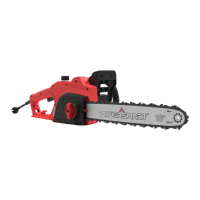15
Cutting logs, branches, etc.
When cutting timber with the chain saw, the left arm should be kept
almost straight. Guide the saw so that no part of your body extends
beyond the imaginary line «X» drawn through the guide bar. Press the
spiked stop on the saw against the timber and only then start cutting
holding the tool by the handle and raising the switch handle (See fig.5).
When limbing, leave larger lower limbs to support the log off the
ground. Remove the small limbs in one cut. Branches under
should be cut from the bottom up to avoid binding the chain saw
(See fig.6).
Trimming trees
Plan retreat paths before beginning to cut, and make sure there are
no obstructions. Always know how to get out of the way of falling
branches.
Make sure bystanders or helpers are a safe distance from falling
branches. Bystanders or helpers should not stand directly in front
or behind the operator.
Maintain solid footing and hold the chain saw firmly with both
hands. Do not overreach. Never climb a tree or ladder to reach
limbs.
Secure any branches that might be hazardous.
Use proper auxiliary equipment.
Prune lower limbs before pruning higher ones.
Allow the saw chain to achieve full speed before cutting.
Apply light pressure to the branch.
For long limbs, cut the end of the limb first (1) to relieve pressure
from the limb, then prune closer to the trunk (2) (See fig.7).
Thick limbs (greater than 4 inch (10 cm) in diameter) can splinter
pinch the chain when making a single cut from the top. To avoid
pinching or splintering, first make one shallow relief cut on the
bottom surface of the limb (1), then cut the limb all of the way
through from the top of the limb (2) to match the bottom cut (See
fig.8).
After most of the limb has been removed, make one smooth cut near
the trunk (See fig.9).
Fig.5
Fig.6
Fig.7
Fig.8
Fig.9

